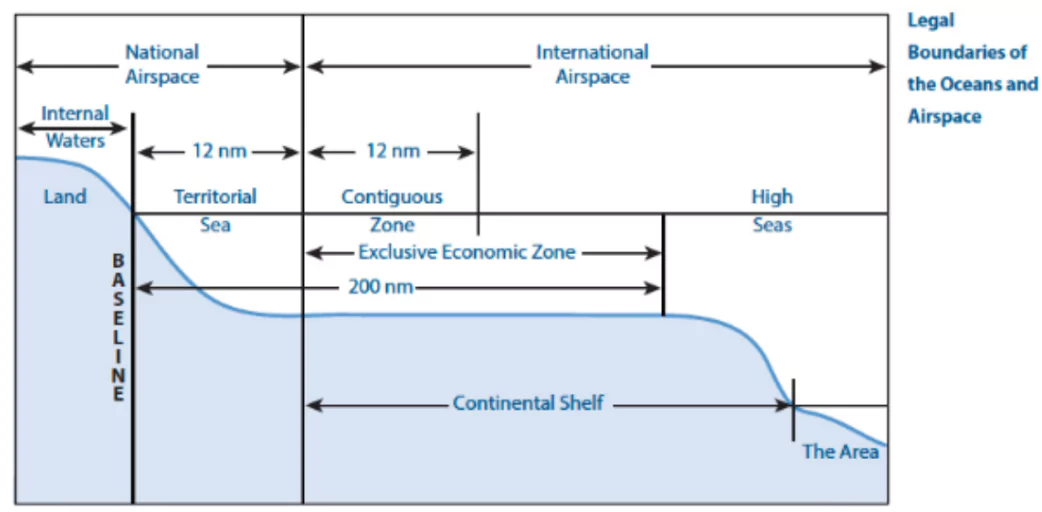Recently, the Union Cabinet, chaired by the Prime Minister, has approved India to sign the Biodiversity Beyond National Jurisdiction (BBNJ) Agreement. The Ministry of Earth Sciences will lead the country’s implementation of the BBNJ Agreement.
- The treaty, negotiated last year, is meant for reducing pollution, and for conservation and sustainable use of biodiversity and other marine resources in ocean waters.
About the Biodiversity Beyond National Jurisdiction Agreement or BBNJ Agreement / the High Seas Treaty
It is an international treaty under the United Nations Convention on the Law of the Sea (UNCLOS). It follows an inclusive, integrated, ecosystem-centric approach based on the precautionary principle and promotes using traditional knowledge and the best available scientific knowledge.
Enroll now for UPSC Online Classes
- Aim: To address the growing concerns over the long-term protection of marine biodiversity in the high seas.
- Adoption: The agreement was adopted by consensus at the 5th BBNJ Intergovernmental Conference in New York on 19th June 2023.
- It is open for signature for two years starting September 2023.
- Secretariat BBJN: Brussels
- Signatories: As of June 2024, 91 countries have signed the BBNJ Agreement, and eight Parties have ratified it.
- It will be an international legally binding treaty after it enters force 120 days after the 60th ratification, acceptance, approval or accession.
- The agreement will be closed for signature on September 20, 2025. This means countries have given their consent to be bound to it and after the deadline,countries can no longer sign but still can accede to the treaty, which has the same legal status as ratification.
- Basis of Agreement: The BBNJ Agreement will be the third implementation agreement under UNCLOS if and when it enters into force, alongside its sister implementation agreements:
- The 1994 Part XI Implementation Agreement (which addresses the exploration and extraction of mineral resources in the international seabed area)
- The 1995 UN Fish Stocks Agreement (which addresses the conservation and management of straddling and highly migratory fish stocks).
- Objectives:
- Conservation and protection of marine ecology
- Fair and equitable sharing of benefits from marine genetic resources
- Establishment of the practice of mandatory environmental impact assessments (EIA) for any activity that is potentially polluting or damaging to the marine ecosystem.
- The EIAs need to be made public. An EIA is to be carried out for activities within national jurisdictions as well if the impacts are expected in the high seas.
- Capacity building and transfer of marine technologies to developing countries.
- This will help them make full use of the benefits of the oceans while also contributing towards their conservation.
- Key Features of the Treaty:
- Environmental Impact Assessments: It introduces requirements to carry out environmental impact studies for proposed activities to be carried out in international waters.
- Benefit Sharing Guidelines: The treaty also establishes principles for sharing the benefits of “marine genetic resources” (MGR) collected by scientific research in international waters.
- Negotiated under UNCLOS: The treaty was negotiated under UNCLOS of 1982 which governs the rights of countries regarding marine resources.
- Biodiversity Conservation: It recognizes the need for biodiversity conservation.
- The ‘High Seas Treaty’ proposes to protect 30% of the world’s oceans and increase funding for marine conservation
- Mandates:
- Sets Precise Mechanisms: For the sustainable use of marine biological diversity through international cooperation and coordination.
- Ensure Fair and Equitable Sharing: Parties cannot claim or exercise sovereign rights over marine resources derived from the high seas and ensure fair and equitable sharing of benefits.
- Helps to Minimise Impacts on the Marine Environment: Through area-based management tools and establishes rules for conducting environmental impact assessments.
- Achievement of SDGs: It would also contribute to achieving several SDGs, particularly SDG14 (Life Below Water).
Benefits of BBNJ Agreement for India
This landmark decision marks a significant step towards the conservation and sustainable utilisation of marine biological diversity in areas beyond national jurisdiction.
- Enhance Strategic Presence: The BBNJ Agreement allows us to enhance our strategic presence in areas beyond our EEZ (Exclusive Economic Zone), which is very promising.
- Strengthen Marine Conservation Efforts and Collaborations: In addition to shared monetary benefits, it will further strengthen the marine conservation efforts and collaborations, open newer avenues for scientific research and development, access to samples, sequences and information, capacity building and technology transfer, etc.
- It is another crucial step towards ensuring that oceans remain healthy and resilient.
About the High Seas
The high seas are areas beyond 200 nautical miles from the exclusive economic zones of coastal countries as defined in the 1958 Geneva Convention.

- Refers: These are areas outside the national jurisdiction of any country because of which the treaty is also known as the agreement on BBNJ. The High Seas Treaty has often been compared with the 2015 Paris Agreement on climate change in its significance and potential impact.
- It is formally called the Agreement on Conservation and Sustainable Use of Marine Biological Diversity of Areas Beyond National Jurisdiction.
- Members: Ninety-one countries have already signed the treaty, while eight of them have also ratified it.
- India, like most other nations, was a party to the nearly 20 years of negotiation that resulted in the finalisation of the treaty last year.
- Common Good: These areas beyond national jurisdiction are the global common oceans open to all for internationally lawful purposes such as navigation, overflight, laying submarine cables and pipelines, etc.
- Extent: The high seas comprise 64% of the ocean surface, and about 43% of the Earth.
- Protection Status: Despite covering more than two-thirds of the global ocean, only 1.44% of the high seas are protected.
- Importance of High Seas:
- Importance and Extent of the High Seas: The high seas account for more than 60% of the world’s ocean area and cover about half of the Earth’s surface, which makes them a hub of marine life.
- Biodiversity of the High Seas: They are home to around 2.7 lakh known species, many of which are yet to be discovered.
- Regulate Climate: The high seas regulate the climate by playing a fundamental role in planetary stability by mitigating the effects of climate change through its absorption of carbon and by storing solar radiation and distributing heat around the globe.
- Anthropogenic Pressures on the High Seas: It include seabed mining, noise pollution, chemical spills and fires, disposal of untreated waste (including antibiotics), overfishing, introduction of invasive species, and coastal pollution.
- Challenge: As these belong to no one, high seas are also no one’s responsibility. As a result, many of these areas suffer from overexploitation of resources, biodiversity loss, pollution, including dumping of plastics, ocean acidification, and many other problems.
- According to UN estimates, about 17 million tonnes of plastics were dumped in the oceans in 2021, and this was only expected to increase in the coming years.
Check Out UPSC NCERT Textbooks From PW Store
About United Nations Convention on the Law of the Sea (UNCLOS)
- Adoption: It came into force in 1982.
- It came into force on November 16, 1994.
- Mandate: It lays down a comprehensive regime of law and order in the world’s oceans and seas establishing rules governing all uses of the oceans and their resources.
- Role:
- It defines the rights and duties of countries in the oceans, the extent of ocean areas over which countries could claim sovereignty, and the legal status of marine resources.
- It also specified a set of general rules for a range of activities in the oceans including navigation, scientific research, and deep-sea mining.
- Members: As of today, more than 160 countries have ratified UNCLOS.
- Significance: It is vital to maintaining order, equity, and fairness in using the world’s oceans.
- It is crucial for the environmental protection of the seas and addressing maritime boundaries, rights to marine resources, and dispute resolution.
- It establishes the International Seabed Authority to regulate mining and related activities on the ocean floor beyond national jurisdiction.
About Ratification
Ratification is the process by which a country agrees to be legally bound to the provisions of an international law.
- Different from Signing: Signing indicates that a country agrees with the provisions of the international law concerned, and is willing to abide by it. But till it ratifies it, the process for which varies from country to country, it is not legally bound to follow that law.
- Process Involved: In countries that have legislative bodies like a parliament, ratification typically requires the consent of the legislature.
- In other countries, it might just need an executive approval or accession.
- It is possible for a country to sign on to but not ratify a treaty.
- In that case, it is not considered a party to the treaty. The United States, for example, signed the Kyoto Protocol, the predecessor to the Paris Agreement, but it did not ratify it because its Senate, the upper house of the legislature, did not give its approval.
|
![]() 10 Jul 2024
10 Jul 2024

